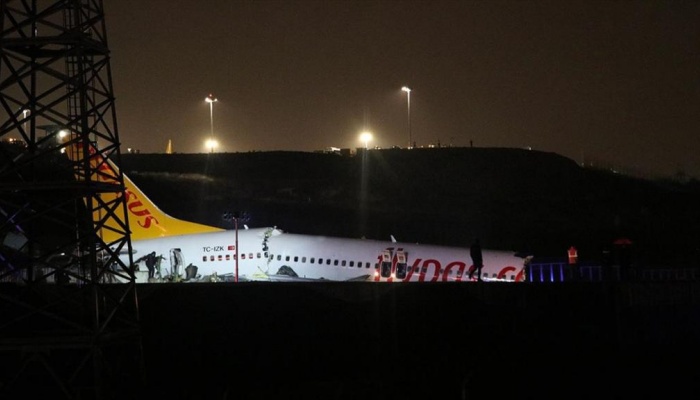An expert report released by the Turkish Transport and Infrastructure Ministry on a plane that crashed at İstanbul’s Sabiha Gökçen International Airport in February states that the pilots were concerned because of a lightning strike six minutes before landing and had used manual braking six seconds later than called for, according to the Hürriyet Daily News.
The expert report was submitted to the İstanbul court that had arrested one of the pilots, Mahmut Arslan, on Feb. 24 on charges of involuntary manslaughter and causing injury.
The second pilot, according to the Diken news website, was a Dutch citizen and could not speak Turkish; however, the instructions from the control tower were given in Turkish.
On Feb. 5, Pegasus Airlines flight PC2193 was arriving from Turkey’s Aegean province of İzmir when it skidded off the runway at Sabiha Gökçen.
The plane skidded around 50 meters, and the nose of the plane almost completely separated from the rest of the fuselage, which burst into flames following the crash. Three people among the 177 passengers and six crew members on board died.
Due to the lightning the pilots wanted to land as soon as possible and avoid any potential problems in the landing, according to the report, referring to the voice recordings between the captain and first officer.
“It was understood that the pilots who received permission to land implemented the approach and landing procedures after making their preparations and that the landing occurred properly, despite the deviation in landing,” the report noted.
“The aircraft could not stop on the runway. It first crashed into the ILS antennas, then the guard booth and finally fell into an area about 30 meters deep at the end of the runway,” it added.
The pilots did not use manual braking for six seconds after the main wheel touched down on the runway, as a result of which the aircraft did not slow down due to the accelerating effect of a tailwind, according to the report.
One the pilots noticed that the plane was not decelerating, so they applied manual braking and continued to do so until the end of the runway, the report said.
The aircraft fuselage, the findings noted, broke into three pieces after hitting a concrete wall and wire fences surrounding the airport. The engines, landing gear, wings and other parts were found to be broken.
The speed of the plane was 84 knots due to the tailwind and did not decrease, prompting the pilots to brake manually six seconds after noticing this, the captain said in his statement, adding that the detection of this abnormality normally should have been made by the first officer.
Pegasus has had several recent instances of overshooting runways.
Another Pegasus Airlines plane skidded off the runway at the same airport on Jan. 7, causing the temporary closure of the airport. There were no injuries.
In January 2018, another Boeing 737 in the Pegasus fleet slid off a runway at Trabzon Airport in northeastern Turkey. The plane came to rest in the dirt above the Black Sea with its nose pointed toward the water. No one was injured.



